
April 21, 2022
Adapting to Employee Turnover
By Brandon Locke
Editor’s note: This is a guest post in our Library Publishing Workflow Evolution series, featuring reflections from our Library Publishing Workflows partners on how journal publishing workflows at their libraries have evolved over time. You can see the full documentation on the Library Publishing Workflows page.
By Jason Colman, writing about his experiences at the University of Michigan Library
In my previous blog post for the LPW project, I mentioned that Michigan Publishing was starting the process of migrating our 40 or so open access journals from our old platform, DLXS, to Janeway. I suggested checking back with me to see if the pain we were experiencing in 2020 had been relieved in 2022. (Was I only talking about workflows there? Not sure.) I’m sure the whole library publishing community has been on tenterhooks waiting for an update, so how are things going at Michigan?

I’m happy to report that about 25 of our journals are now publishing their new issues on Janeway, thanks to the efforts of our editors, production crew, conversion vendor, and developers at Michigan and Janeway. As we were approaching the halfway mark, some other happy news happened that cast a bright spotlight on the importance of workflow documentation: Digital Publishing Coordinator (and my partner on the LPW project at Michigan), Joseph Muller, landed a great new job working for Janeway at the Birkbeck Centre for Technology and Publishing. Suddenly, our original Janeway expert was leaving the team.
It’s never easy to lose a hard-working colleague like Joe, but we were incredibly lucky that he had followed the lessons of the LPW project and created excellent process documentation for publishing our journals on Janeway that the rest of the production team were already using actively every day. Now, six months after Joe’s departure, we have a new Digital Publishing Coordinator hired. She’s learning her job in large part from the documentation he started, and that the team has been refining ever since.
Without a doubt, colleagues at our library publishing operations will (and should!) move on to new opportunities when it makes sense for them to. This is even more true now, I think, with so many interesting roles popping up in the community. I’ve discovered that I’m only able to help my team adapt to the temporary absence of a colleague if the workflow that position is responsible for managing is documented very clearly. Like all library publishers, we’ll never have enough redundancy on our teams for this not to be true.
So, if I’ve learned anything as a manager going through this process, it’s that the best time to write workflow documentation is before you desperately need it, because you will desperately need it.
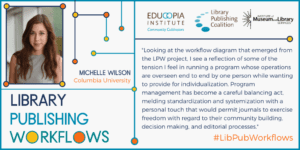
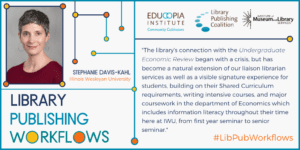
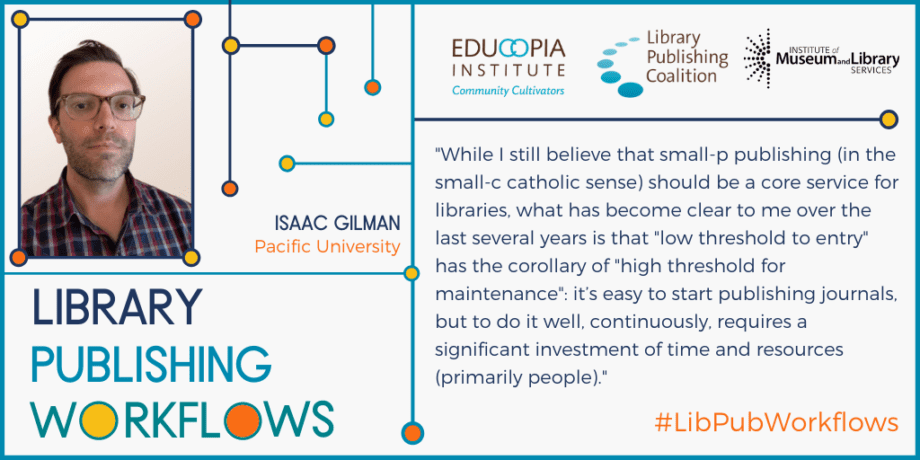
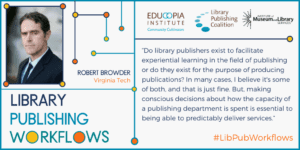 So, what is the best workflow for libraries who wish to publish journals? It depends. While our documented workflows provide a progression of steps that describe the production work performed by publishers, the greater context within which a particular workflow succeeds is much tougher to represent. The LPC’s Library Publishing Directory is probably the best resource available for gathering context. For best results, I recommend using these workflow documents in combination with the Library Publishing Directory entry for each institution. Together, these documents form a clearer picture than either of them do on their own. However, even with both of these documents in hand the picture may still not be completely clear.
So, what is the best workflow for libraries who wish to publish journals? It depends. While our documented workflows provide a progression of steps that describe the production work performed by publishers, the greater context within which a particular workflow succeeds is much tougher to represent. The LPC’s Library Publishing Directory is probably the best resource available for gathering context. For best results, I recommend using these workflow documents in combination with the Library Publishing Directory entry for each institution. Together, these documents form a clearer picture than either of them do on their own. However, even with both of these documents in hand the picture may still not be completely clear. 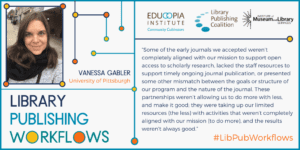 In the early days of our publishing program (2008–2011), we were flipping Pitt faculty print subscription journals to online with delayed open access, starting new open access journals with Pitt Faculty, and then taking on new and existing open access journals from non-Pitt partners around the world. We were so excited! And we still are, but we learned some lessons along the way. Some of the early journals we accepted weren’t completely aligned with our mission to support open access to scholarly research, lacked the staff resources to support timely ongoing journal publication, or presented some other mismatch between the goals or structure of our program and the nature of the journal. These partnerships weren’t allowing us to do more with less, and make it good; they were taking up our limited resources (the less) with activities that weren’t completely aligned with our mission (to do more), and the results weren’t always good.
In the early days of our publishing program (2008–2011), we were flipping Pitt faculty print subscription journals to online with delayed open access, starting new open access journals with Pitt Faculty, and then taking on new and existing open access journals from non-Pitt partners around the world. We were so excited! And we still are, but we learned some lessons along the way. Some of the early journals we accepted weren’t completely aligned with our mission to support open access to scholarly research, lacked the staff resources to support timely ongoing journal publication, or presented some other mismatch between the goals or structure of our program and the nature of the journal. These partnerships weren’t allowing us to do more with less, and make it good; they were taking up our limited resources (the less) with activities that weren’t completely aligned with our mission (to do more), and the results weren’t always good.
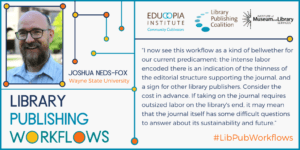
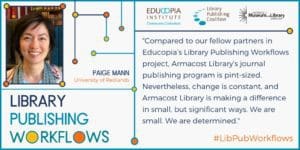
![Quote from Sonya Betz, University of Alberta: [Approaching our relationship with journals as a partnership rather than a service] represents a significant shift for us in how we understand our role in this work—as more journals join our program...we’ve become increasingly comfortable taking a principled stance for ethical open access, and requiring the journals we partner with to agree to standards such as barrier-free open access, no APCs, and Creative Commons licenses.](https://librarypublishing.org/wp-content/uploads/2021/11/sonya-evolution-300x150.jpeg)